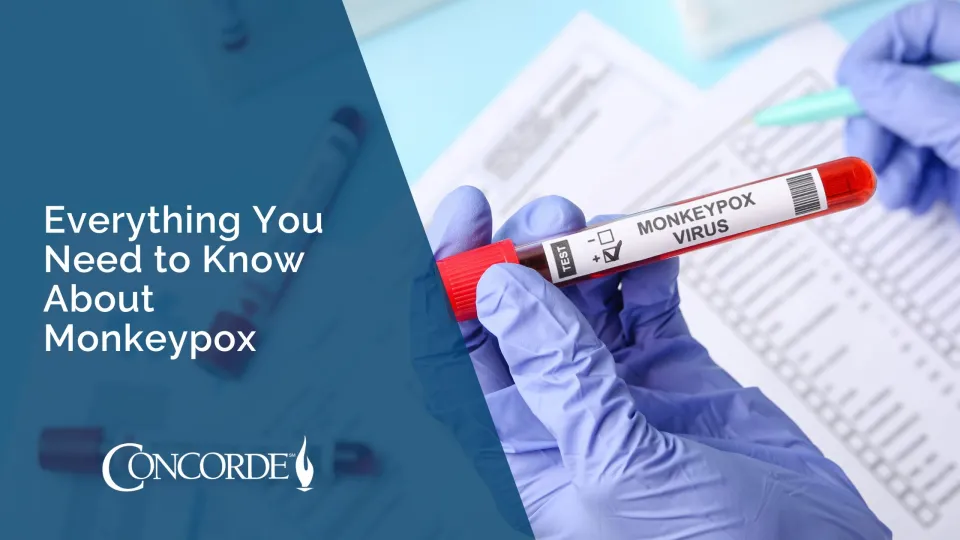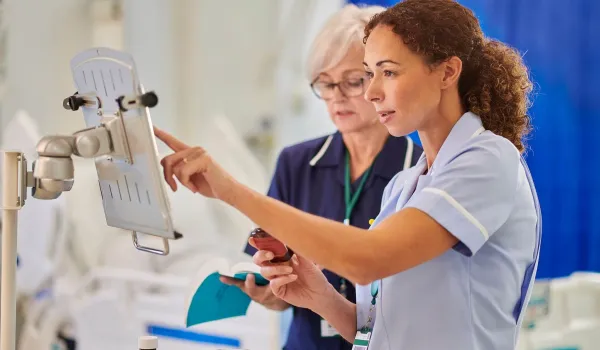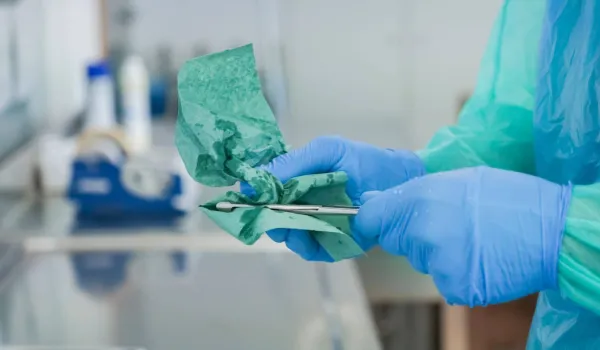
Monkeypox is a zoonosis caused by the monkeypox virus (3). Zoonoses are diseases that spread from animals to humans and then transmit between humans. The monkeypox virus typically affects small rodents, such as rats or mice, and other nonhuman primates like monkeys. Humans can contract monkeypox after close contact with an infected animal or human (2). Monkeypox is most commonly found in Africa, and the virus has two types (clades): the West African clade and the Central African clade. The current 2022 world outbreak of monkeypox is caused by the milder West African clade (3).
Monkeypox in Context
The monkeypox virus was first observed in 1958. The disease broke out among groups of monkeys being used for scientific research. While the disease is called monkeypox, its origin is still unknown, and it has been found in a variety of African rodents and nonhuman primates (1). The disease was first observed in animals and has since spilled over to humans. This means humans should take steps to prevent the spread from person to person, person to animal, and animal to person.
The monkeypox virus is a part of the same group of viruses as the variola virus, which includes the virus that causes smallpox. Monkeypox symptoms are similar to smallpox; however, monkeypox is usually milder than smallpox and is rarely fatal. The first recorded case of monkeypox in humans was in 1970. Before 2022, monkeypox had only been reported in central and western African countries. Cases of monkeypox outside Africa had previously been associated with the importation of infected animals or travel to countries where the disease was common (1).
Clinical Signs of Monkeypox
People with monkeypox can exhibit a variety of symptoms. However, the most distinctive clinical sign is a painful and itchy rash commonly located on or near the genitals (i.e., penis, testicles, labia, and vagina), anus, or other areas of the body, such as the hands, feet, chest, face, or mouth. The rash can look like pimples and will progress by filling with pus, scabbing over, and eventually healing. To avoid scarring, it is important to avoid scratching the pustules and to let them heal on their own (1).
Other symptoms might include those common to other viruses and diseases. These include fever, chills, swollen lymph nodes, fatigue, muscle aches, backache, sore throat, nasal congestion, or cough. People sometimes only experience a few of these symptoms. Additionally, some people experience flu-like symptoms before developing a rash or will develop a rash and then flu-like symptoms. Others might not experience any symptoms. Monkeypox symptoms develop within three weeks of exposure. If an infected person has flu-like symptoms, they will usually develop a rash within four days. The course of disease lasts between two and four weeks (1).
Testing Individuals should seek medical care if they develop any of the symptoms listed above or if they've been in contact with someone who is infected (3, 4). If a person believes they might have monkeypox, they should self-isolate and minimize their contact with other people. When seeking medical care, it is important for those who suspect they have monkeypox to disclose this information to all staff they might come in contact with so they can take proper precautions (1).
Monkeypox is a rare disease. This means health care providers will likely attribute symptoms to other, more common diseases like measles or chickenpox before considering monkeypox (3). To provide a definitive diagnosis of monkeypox, a health care provider must take a sample from one of the blisters and send it to a laboratory (3). If a patient does not have sores or blisters, the health care provider might take a blood sample to test for the presence of monkeypox antibodies (3). Test results are usually available within a few days (1).
Precautions
Monkeypox spreads through close physical contact with infected people or objects they've handled (e.g., clothes, bedding, towels, dishes, etc.). Close physical contact includes kissing, hugging, cuddling, and having sex with an infected person. Additionally, it is important to avoid contact with any open sores or lesions on an infected person. Therefore, if you or someone you are close to is suspected to have monkeypox or tests positive for the virus, maintaining isolation is critical to limit the spread. Good hygiene, including hand-washing after being in public spaces and using the bathroom, also helps prevent disease spread (1).
Monkeypox also spreads through close contact with infected animals. A person can contract monkeypox from an infected animal through bites or scratches, direct contact with fluids or rashes from infected animals, products made from an infected animal, or consumption of an infected animal (2). Therefore, it is important to avoid contact with infected animals, whether dead or alive, and to alert the proper public health authorities of any suspected infected animals. Additionally, if you suspect you might have or test positive for monkeypox, avoid contact with animals during the infection to help limit the spread of the virus.
Vaccination is another method of protection against monkeypox. Physicians only recommend high-risk individuals get vaccinated against monkeypox. High-risk individuals include people who have had a sexual partner with monkeypox in the last two weeks, people who have had multiple sexual partners in the previous two weeks in an area with known monkeypox cases, and health care or laboratory workers who might come in contact with the virus during their daily work. The preferred vaccine for monkeypox is JYNNEOS, which comprises two doses. A person is most protected two weeks after their second dose of the JYNNEOS vaccine (1).
The ACAM200 vaccine is an alternative to the JYNNEOS vaccine; however, it has a higher risk of adverse reactions and side effects. The ACAM2000 vaccine is a single-dose vaccine that takes four weeks to provide maximal protection against monkeypox. The ACM2000 vaccine is not recommended for people with weakened or compromised immune systems due to the increased risk of adverse reactions (1).
Treatment
The current treatment for monkeypox is limited to symptom management; the disease currently has no cure. Infected individuals should self-isolate and have minimal contact with other people or pets while infected. Symptom management might include taking pain relievers such as ibuprofen and fever reducers like acetaminophen to help alleviate discomfort. In severe cases, individuals might receive the antiviral medication used to treat smallpox, because the two diseases are genetically similar (1).
People with weakened immune systems are more likely to develop a severe case of monkeypox and might require medical treatment to help manage their recovery (1). Vaccination might also help infected individuals, especially if given shortly after infection (2).
Therefore, if you develop symptoms of monkeypox or receive a positive test result, it is important to ask your health care provider if they have any available vaccinations.
In addition to treating fever and pain, individuals can take steps to manage the discomfort of their rash. Oatmeal baths can help relieve skin dryness and itchiness associated with skin lesions. Covering affected areas with gauze can also help curb the spread of the rash and might prevent scratching or itching of the area, which helps with the healing process (3).
Infected individuals should also take precautions around other people, especially if they share a living space. When around others, wear a well-fitting mask and avoid physical contact. It is also essential to clean and disinfect frequently touched surfaces, especially in shared spaces. Infected individuals should also use their own towels and, if possible, bathroom. However, if this is not possible, they should disinfect surfaces and keep their personal items in a separate location from other people living with them (3).
Potential Complications
Monkeypox, while rarely fatal, can result in several complications. These complications can include severe scars on the face, arms, and legs, blindness, and subsequent infections. It is important to note the current monkeypox strain is not usually fatal (2). Additionally, most people infected with monkeypox recover fully within two to four weeks of symptom onset (1). Monkeypox remains a rare disease that is not easily transmitted without close physical contact (2).
Monkeypox, a disease rarely seen outside of Africa, has been recently observed in countries around the world. However, despite its growing global presence, the disease is not very common. The best ways to protect against infection include avoiding close physical contact with infected people or animals and vaccinating at-risk individuals (1).
Public health officials and medical professionals are monitoring the current global outbreak of this disease closely and working to develop better treatments and prevention methods to protect people (1). Infected individuals should contact their health care providers to discuss testing and treatment options and should abide by their local public health guidelines.
Footnote
1. "Monkeypox in the U.S.," Centers for Disease Control and Prevention, https://www.cdc.gov/poxvirus/monkeypox/about.html
2. "Monkeypox," Cleveland Clinic, https://my.clevelandclinic.org/health/diseases/22371-monkeypox
3. "What is monkeypox, how does it spread and how can it be prevented?" Mayo Clinic, https://www.mayoclinic.org/diseases-conditions/infectious-diseases/expert-answers/monkeypox-faq/faq-20533608
4. "How the Medical Field is Adapting to Prepare for Future Healthcare Crises," Concorde, /blog/how-medical-field-adapting-prepare-future-healthcare-crises
Take The Next Step Towards a Brighter Future
We have a Concorde representative ready to talk about what matters most to you. Get answers about start dates, curriculum, financial aid, scholarships and more!




